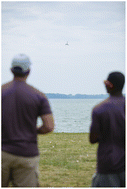Drone-based particle monitoring above two harmful algal blooms (HABs) in the USA†
Abstract
Little is known about the transport and fate of aerosolized particles associated with harmful algal blooms (HABs). An Airborne DROne Particle-monitoring System (AirDROPS) was developed and used to monitor, collect, and characterize airborne particles over two HABs in Grand Lake St Marys (GLSM) and Lake Erie (LE), Ohio USA in August 2019. The AirDROPS consisted of an impinging device (ID) and an optical particle counter (OPC) mounted on a large commercial quadcopter (DJI Inspire 2). The sensor package was mounted above the airframe to limit the effects of propeller downwash that can corrupt measurements taken below the drone. Nineteen flights were conducted 10 m above water level (AWL) at GLSM, and five flights were conducted 10 m AWL at LE. The sampling height was chosen to minimize the effects of propwash on aerosolization from the lake surface. One intercomparison flight was conducted at GLSM over land adjacent to a sonic anemometer mounted on the top of a flagpole 15 m above ground level (AGL). Particle counts generally decreased from morning to afternoon flights, ranging from >4000 in the morning to <1000 later in the day. Decreased particle counts were associated with an increase in windspeed that corresponded with time of day, ranging from >4000 below 4 m s−1 to <2500 above 4 m s−1. Flow cytometry was used to image particles trapped in a liquid impinger onboard the AirDROPS. Sixty percent (15/25) of the impinger samples contained at least one biotic (fluorescent) object. Impinger samples were also analyzed for a suite of potential cyanotoxins using liquid chromatography-mass spectrometry (LC-MS/MS), but no cyanotoxins were detected in any of these air samples (water samples collected during a similar time contained greater than 20 μg L−1 microcystins). Additional work is needed to understand the environmental factors associated with the potential aerosolization and transport of cyanobacterial cells and toxins in aquatic environments.

- This article is part of the themed collections: Bioaerosols: detection, transport and risk assessment and Applications of Unmanned Aerial Systems in Atmospheric Science


 Please wait while we load your content...
Please wait while we load your content...